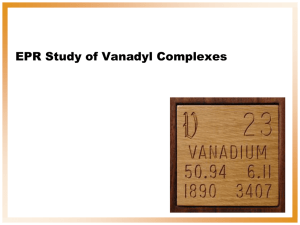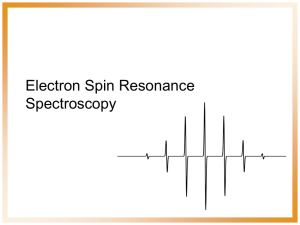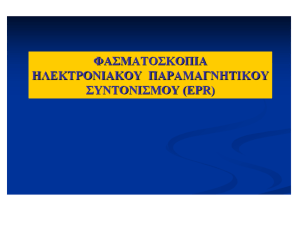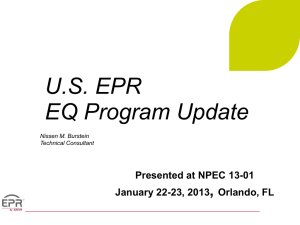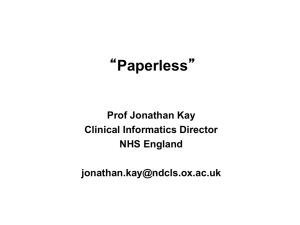Paper
advertisement
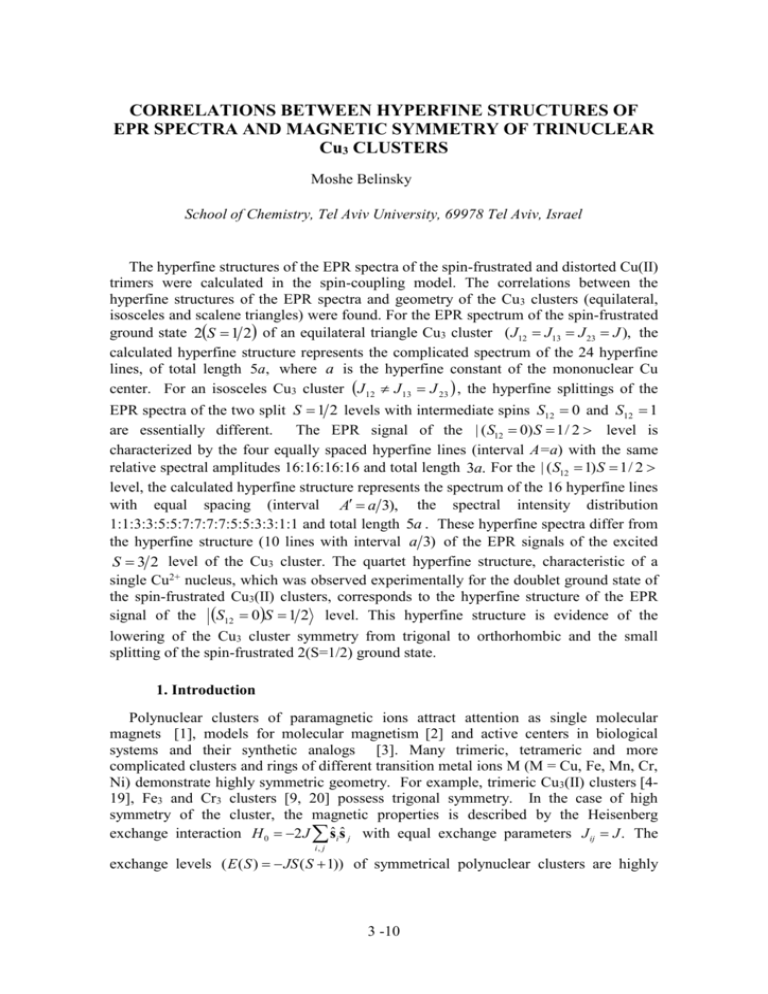
CORRELATIONS BETWEEN HYPERFINE STRUCTURES OF
EPR SPECTRA AND MAGNETIC SYMMETRY OF TRINUCLEAR
Cu3 CLUSTERS
Moshe Belinsky
School of Chemistry, Tel Aviv University, 69978 Tel Aviv, Israel
The hyperfine structures of the EPR spectra of the spin-frustrated and distorted Cu(II)
trimers were calculated in the spin-coupling model. The correlations between the
hyperfine structures of the EPR spectra and geometry of the Cu3 clusters (equilateral,
isosceles and scalene triangles) were found. For the EPR spectrum of the spin-frustrated
ground state 2S 1 2 of an equilateral triangle Cu3 cluster ( J12 J13 J 23 J ), the
calculated hyperfine structure represents the complicated spectrum of the 24 hyperfine
lines, of total length 5a, where a is the hyperfine constant of the mononuclear Cu
center. For an isosceles Cu3 cluster J 12 J 13 J 23 , the hyperfine splittings of the
EPR spectra of the two split S 1 2 levels with intermediate spins S12 0 and S12 1
are essentially different. The EPR signal of the | ( S12 0) S 1/ 2 level is
characterized by the four equally spaced hyperfine lines (interval A=a) with the same
relative spectral amplitudes 16:16:16:16 and total length 3a. For the | ( S12 1) S 1/ 2
level, the calculated hyperfine structure represents the spectrum of the 16 hyperfine lines
with equal spacing (interval A a 3), the spectral intensity distribution
1:1:3:3:5:5:7:7:7:7:5:5:3:3:1:1 and total length 5a . These hyperfine spectra differ from
the hyperfine structure (10 lines with interval a 3) of the EPR signals of the excited
S 3 2 level of the Cu3 cluster. The quartet hyperfine structure, characteristic of a
single Cu2+ nucleus, which was observed experimentally for the doublet ground state of
the spin-frustrated Cu3(II) clusters, corresponds to the hyperfine structure of the EPR
signal of the S12 0S 1 2 level. This hyperfine structure is evidence of the
lowering of the Cu3 cluster symmetry from trigonal to orthorhombic and the small
splitting of the spin-frustrated 2(S=1/2) ground state.
1. Introduction
Polynuclear clusters of paramagnetic ions attract attention as single molecular
magnets [1], models for molecular magnetism [2] and active centers in biological
systems and their synthetic analogs [3]. Many trimeric, tetrameric and more
complicated clusters and rings of different transition metal ions M (M = Cu, Fe, Mn, Cr,
Ni) demonstrate highly symmetric geometry. For example, trimeric Cu3(II) clusters [419], Fe3 and Cr3 clusters [9, 20] possess trigonal symmetry. In the case of high
symmetry of the cluster, the magnetic properties is described by the Heisenberg
exchange interaction H 0 2 J sˆ i sˆ j with equal exchange parameters J ij J . The
i, j
exchange levels ( E ( S ) JS ( S 1)) of symmetrical polynuclear clusters are highly
3 -10
degenerate: the total spin S Smax corresponds to two or more different intermediate
spins S ij [6, 7, 9] (or the spin-frustration effect [1a, 11a, 13, 20-23]). In the trigonal
trinuclear clusters, the highly degenerate nS levels correspond to
2 S 1
E,
2 S 1
A1 and
2 S 1
A2 trigonal multiplets [6,7,9]. The high degeneracy or spin-frustration of the spin nS
levels of the symmetrical pure Heisenberg model is very sensitive to the interplay
between the exchange parameters, local anisotropy and symmetry lowering. The nonHeisenberg exchange interactions, such as the Dzialoshinsky-Moriya antisymmetric
exchange H DM Dij [ si s j ] , biquadratic exchange H BE jij (si s j )2 [9] and the
“magnetic Jahn-Teller effect” [24, 20a] split the spin-frustrated nS levels.
Exchange-coupled Cu3(II) clusters in synthetic and native systems have been the
subject of experimental and theoretical investigations [3c, 4-19, 25-29]. Trigonal
antiferromagnetic Cu3(II) clusters ( J12 J13 J 23 J ) with the degenerate ground state
2(S=1/2) represent the simplest case of the spin-frustrated clusters. Recently, the
hyperfine structure of the EPR spectra of the spin-frustrated ground state with S 1 2
of the trigonal Cu3 clusters was observed in [16, 19]. The EPR spectrum of the spinfrustrated ground state with S 1 2 possesses a quartet hyperfine structure [19],
characteristic of a single Cu2+ site, that was explained in [19] by the localization of the
repaired electron orbital on only one of the three nuclei of the Cu3 trimer. The
complicated hyperfine multiplets, which were observed in EPR spectra of the 2(S=1/2)
ground state of the spin-frustrated Cu3 cluster , were not explained.
The model of the hyperfine splittings of the EPR signals for spin-frustrated
trigonal and distorted Cu3 clusters is considered in this paper. The hyperfine splittings of
the EPR spectra of spin-frustrated Cu3 clusters with the geometry of an equilateral
triangle were calculated and compared with the hyperfine splittings for the distorted
(isosceles and scalene) Cu3 clusters and experimentally observed hyperfine structures.
2. Spin-Coupling Model
The spin Hamiltonian of the Cu3(II) trimer in the spin-coupling model has the form
H 2 J ij sˆi sˆ j ( sˆi gi H sˆii Iˆ i ),
(1)
i 13
i, j
where gˆ i is the g-tensor, â i the hyperfine splitting tensor and sˆ i and Iˆ i are the
electron and nuclear spin operators of the i ion of the triad, respectively [6, 9, 37]. The
correlations between the individual g-factors {effective hyperfine constants}and
molecular g-factors {single-ion hyperfine constants} for trimers were considered. [5-7,
9, 10, 25, 26, 30].
For the spin-frustrated clusters with equilateral triangle geometry, considering
that the three Cu metals are almost structurally equivalent and J12 J13 J 23 J , the
spin Hamiltonian has the form ( H H z )
H 2 J (sˆ sˆ sˆ sˆ sˆ sˆ ) gSˆ H a(sˆ Iˆ sˆ Iˆ sˆ Iˆ ).
(2)
0
1 2
2 3
1 3
Z
Z
We assume that all individual g-factors
g 2 g3 g ) and form the cluster g-factor g ||
EPR spectra were observed for the parallel
hyperfine constant (AZZ = 157G [19]) is
1Z 1Z
2Z 2Z
3Z 3Z
in the trigonal cluster are equal (g1
g . Since the hyperfine splittings of the
cluster g-factor [19, 16] and the cluster
close to the hyperfine constant of the
3 -11
mononuclear Cu(II) center ( a = 16-18 10-3 cm-1), we shall suppose that the local z
components of the individual hyperfine tensors are parallel to the molecular Z-axis of
the cluster and consider only Z components of the hyperfine interaction since
a zz a xx , a yy . We assume that all individual hyperfine tensors are equal ai azz a .
In the trigonal clusters with J ij J 1000 - -20 cm-1. [4, 5, 7-9, 11-19], strong
antiferromagnetic exchange (2) (J g H a ) results in the degenerate 2(S= 1/2)
ground state, Fig.1a. The excited S 3 2 level is separated by the interval 3J from the
ground spin-frustrated state 2S 1 2 . The effective spin Hamiltonian for the S 3 2
level of the trigonal cluster includes the axial operator of zero-field splitting [31]:
ˆ .
(3)
H D0 SˆZ2 S S 1 3 SgH
Figure 1. a) The Zeeman splitting of the degenerate spin-frustrated 2(S=1/2) ground
state of the trigonal Cu3 cluster, J12 J13 J 23 J . b) The Zeeman splittings and
EPR transitions for the |(0)1/2> and |(1)1/2> spin levels of the Cu3 cluster with the
geometry of an isosceles triangle, J12 J13 J 23 J .
For the Cu3 cluster with isosceles triangle symmetry J13 J 23 J , J12 J , the
Heisenberg exchange interaction H1
H1 2 J12sˆ1sˆ 2 2 J sˆ1sˆ 3 sˆ 2sˆ 3 ,
(4)
E1 S12 S J S S 1 3 4 ( J J12 ) S12 S12 1 ,
results in the splitting of the four-degenerate spin-frustrated ground state 2S 1 2
on
the
separated
Kramers
doublets
E1 S12 0 S 1 2 0,
E1 S12 1 S 1 2 2 , J J12 , [5-7, 9, 10, 25, 26] which are characterized by
the intermediate spin S12 ( S12 s1 s 2 , S S12 s3 ), Fig. 1b.
In the case of the spin-frustrated trigonal Cu3 cluster ( J ij J , 0), both the
| ( S12 0) S 1/ 2 and | ( S12 1) S 1/ 2 levels have the same energy and form the
four-fold degenerate spin-frustrated ground state 2(S=1/2). In the case gi g , the
3 -12
Zeeman 2 M S levels of the ground spin-frustrated state 2S 1 2 are two-fold
degenerate (Fig. 1a). Both EPR transitions between these Kramers doublets are
characterized by the same molecular g-factor.
The wave functions of the spin-frustrated ground state of the Cu3 center have the form
(S12 , S , M S , m1 , m2 , m3 , M I ) [(S12 )SM S ]1 ( I1 , m1 )2 ( I 2 , m2 )3 ( I3 , m3 ),
where the electronic ground state wave functions [( S12 ) SM S ] (S12 = 0, 1; S = 1/2,
M S 1/ 2) diagonalize the Heisenberg exchange Hamiltonian (eqs. (2), (4)) and
Zeeman interaction. i Ii , mi is the nuclear wave function of the i ion, Ii 3 2 for Cu
nuclei, the projection M I m1 m2 m3 of the total nuclear spin I has the value MI=
9/2(1), 7/2(3), 5/2(6), 3/2(10), 1/2(12); I I1 I 2 I3 . To find the hyperfine splittings
for the degenerate 2 M S Zeeman levels (Fig. 1a) of the spin-frustrated ground state
2(S=1/2), it is necessary to diagonalize the hyperfine matrix [128 128]
( 2 2 I 1 128).
3
Figure 2. Calculated hyperfine structure of the EPR signal of the spin-frustrated
2(S=1/2) ground state of the trigonal Cu3 cluster.
Fig. 2 shows the calculated hyperfine structure of the EPR transition (Fig. 1a) of
the spin-frustrated ground state 2S 1 2 of the Cu3 cluster with the geometry of an
equilateral triangle [37]. This hyperfine (HF) spectrum consists of the 4 HF lines with
intensity 11, eight HF lines with intensity 6 and 12 HF lines with intensity 3. The
relative spectral amplitudes of the 24 HF lines of the total intensity 128 follow the ratio
of 3:3:6:3:6:6:11:3:3:6:11:3:3:11:6:3:3:11:6:6:3:6:3:3. The positions of the HF lines n
in Fig. 2 and corresponding HF components are represented in [37]. The resulting
calculated HF spectrum of EPR signal of the spin-frustrated ground state 2S 1 2
represents the complicated HF structure, of extent 5a, with hyperfine lines of different
intensities, separated by different HF intervals.
Let us consider the hyperfine structures of the EPR transitions 1 and 2 (Fig. 1b)
of the Kramers doublets | ( S12 0) S 1/ 2 and | ( S12 1) S 1/ 2 respectively,
separated by the exchange interval 2J J12 2 in an isosceles Cu3 triangle (eq. 4).
For the |(0)1/2> state, the non-zero matrix element of the spin operators has the form
(0)1/ 2, M S | sˆ3 z | (0)1/ 2, M S M S [9, 10, 25] and only one ion determines the HF
3 -13
splittings. The effective Hamiltonian of the hyperfine interaction for the MS Zeeman
levels of the 01 2 state has the form
aSˆZ Iˆ3Z .
H HF
(5)
For EPR transition 1 (Fig.1b), the hyperfine interaction (5) results in four HF peaks
with equal spacing, which are represented in Fig. 3a.
Figure 3. Calculated hyperfine structure of the EPR transitions of two S=1/2
levels of the Cu3 cluster with the geometry of an isosceles triangle. a) the
| (S12 0)S 1/ 2 level; b) the | (S12 1)S 1/ 2 level.
The relative spectral amplitudes of the four HF lines follow the ratio
16:16:16:16, with total intensity (2I+1)3=64. The positions of the calculated HF peaks
are -3a/2, -a/2, +a/2 and +3a/2. The intervals between the HF lines are equal A=a. The
length of the hyperfine spectrum is 3a.
For the | ( S12 1) S 1/ 2 spin state of an isosceles triangle Cu3 cluster, the
effective Hamiltonian of the hyperfine interaction for the MS Zeeman levels has the
form
"
H HF
2aSˆZ IˆZ / 3 aSˆZ Iˆ3Z ,
(6)
where Iˆ is the operator of projection of the total nuclear spin. The hyperfine
Z
structure of EPR transition 2 (Fig. 1b) for the 11 2 level is represented in Fig. 3b
(solid lines) in comparison with the HF spectrum of EPR transition 1 (dash-dotted
lines) [37].
The HF spectrum of EPR transition 2 represents the 16 equally spaced
hyperfine lines with the spectral intensity distribution 1:1:3:3:5:5:7:7:7:7:5:5:3:3:1:1.
3 -11
The interval between the HF peaks is A a 3. The total extent of this HF spectrum is
5a. The positions of the HF peaks and HF components are represented in [37].
The HF structure (Fig. 2) of the EPR transition of the spin-frustrated 2(S=1/2)
ground state is not the simple superposition of HF spectra in Fig. 3a and Fig. 3b of EPR
transitions 1 (|(0)1/2>) and 2 (|(1)1/2>) in Fig. 1b due to the hyperfine mixture of the
degenerate 2MS Zeeman levels of the spin-frustrated 2(S=1/2) state.
Figure 4. The hyperfine structure of EPR signals of the excited S=3/2 state of the
Cu3 cluster.
Fig. 4 shows the hyperfine structure of the all allowed EPR transitions for the S
= 3/2 state of the Cu3 cluster. For the S=3/2 state, the correlation | siZ | M S / 3, i=1, 2,
3 takes place and the effective Hamiltonian of the hyperfine interaction has the form
*
H HF
aSˆZ IˆZ 3 .
(7)
The hyperfine spectrum (Fig. 4) represents the 10 equally spaced HF peaks with
the follow spectral intensity distribution: 1:3:6:10:12:12:10:6:3:1. The interval between
the HF lines is A* a 3 . The total length of the HF spectra is 3a. The HF structure for
the EPR transitions in the S=3/2 exchange level does not depend on the symmetry of the
Cu triangle and corresponds to the ferromagnetic ordering of all spins in the trimer [38].
Figure 5. The hyperfine structure of the EPR signal of the ground S=1/2 state of the
scalene Cu3 cluster. J13 / J12 0.9, J 23 / J12 0.8.
In the case of the scalene cluster ( J12 J13 , J12 J 23 , J13 J 23 ), each Kramers
doublet is the mixture of the |(0)1/2> and |(1)1/2> states
3 -12
1,2 (1/ 2) c | (1)1/ 2 c | (0)1/ 2 ,
c
1
(8)
2.
2 J 12 J 13 J 23 1 , 1 2[J J J J12 J13 J12 J 23 J13 J 23 ] .
2
12
2
13
2
23
1/ 2
1 E1 1 2 E2 1 2 is the interval between two Kramers doublets [4, 30, 9, 10,
25].. The HF splittings strongly depend on relations J 13 J 12 and J 23 J 12 . The HF
spectrum of the EPR signal for the ground state of the scalene Cu3 site
with
J13 J12 0.9, J 23 J12 0.8 is represented in Fig. 5 in comparison with the HF structure
of the EPR signal of the pure
01 2
level (dash-dotted lines). The slight scalene
deformation ( J13 J 23 1.125) of an isosceles Cu3 cluster results in the disappearance of
the high-intensity quartet hyperfine spectrum characteristic of the 01 2 level [37].
In the trigonal Cu3 cluster J 12 J 13 J 23 J with degenerate 2(S=1/2) ground
state, the Dzialoshinsky-Moriya antisymmetric exchange interactions [32]
Z
H DM D12Z s1 s2 Z D23
(9)
s2 s3 Z D31Z s3 s1 Z
splits the degenerate 2(S=1/2) state [7, 9]. (The Dzialoshinsky-Moriya antisymmetric
exchange determines the chiral vector k 2([s1 s2 ] [s2 s3 ] [s3 s1 ]) / 3 3 in the
geometrically frustrated magnetic systems: kagome’ lattices that are composed of
equilateral triangles of transition metals [33].) The splitting of the degenerate 2(S=1/2)
ground state by the Dzialoshinsky-Moriya antisymmetric exchange has the form
Z
Z
3 is
D31
E 1 2 3 GZ 2, where the cluster vector parameter G Z D12Z D23
directed along the trigonal Z-axis of the trigonal Cu3 cluster [7, 9].
In the case of the
splitting of the spin-frustrated 2S 1 2 state by the antisymmetric exchange (9), all
three ions are equivalent and effective Hamiltonian of the hyperfine interaction has the
*
form H HF
aSˆZ IˆZ 3 (7) for the E 1 2 Kramers levels. The hyperfine structure of
all EPR signals ( H H Z ) has the form of the 10 hyperfine lines with equal spacing
( A* a 3) which follow the spectral intensity distribution 1:3:6:10:12:12:10:6:3:1 and
with total length 3a, represented in Fig. 4.
3. Discussion
The hyperfine spectra (Figs. 2-5) of the EPR transitions of the spin-frustrated
trigonal Cu3 cluster, isosceles triangle and totally distorted (scalene) Cu trimers are
essentially different. A comparison of the calculated hyperfine spectra (Figs. 2-5) with
the observed HF structure [19] of the spin-frustrated Cu3 cluster, which is characteristic
of a single Cu(II) nucleus, indicates that the hyperfine structure observed in the EPR
experiment can be attributed to the S12 0S 1 2 level of the isosceles triangle
(Fig. 3a). The observed [19] quartet hyperfine structure is not described by the spinfrustrated HF structure (Fig. 2). The observation of the well resolved quartet HF
structure of the EPR signal of the Cu3 spin-frustrated cluster is the evidence of
symmetry lowering, and small splitting 2 of the 2(S=1/2) ground manifold on the
S12 0S 1 2 and S12 1S 1 2 Kramers doublets. The hyperfine structure of
the second EPR transition of the |(1)1/2> level (Fig. 3b) was not resolved due to small
interline HF intervals. The observed HF characteristics of S=1/2 ground state of the Cu3
clusters [15, 16] may also be explained in the spin-coupling model with small
3 -13
distortion and with quartet hyperfine structure of
S12 0S 1 2
the EPR spectra of the
level , Fig. 3a.
The calculated HF structures (Figs. 3a, 3b) may be used for consideration of the
hyperfine structure [29] of the EPR transitions of the S=1/2 levels of an isosceles Cu3
triangle and solutions of the trinuclear Cu(II) clusters.
For dimeric Cu(II) clusters [36], the Bleany-Bowers spin-coupling model
describes the observed hyperfine structure: the 7 equidistant (A=a/2) hyperfine lines
with intensities 1:2:3:4:3:2:1 for the EPR transitions in the triplet state. Figs. 2-5 show
that the spin-coupling model describes also the hyperfine structures of EPR spectra of
all spin levels of the Cu3 clusters with geometries of equilateral, isosceles and scalene
triangle. The spin-coupling model of hyperfine splittings provides the correlations
between the hyperfine structures and magnetic symmetry of the trinuclear Cu3 clusters.
4. Conclusion
The hyperfine structures of the EPR transitions are very specific for the spinfrustrated Cu3 clusters with geometries of an equilateral triangle and distorted isosceles
and scalene trimers. The quartet hyperfine structure, characteristic of a single Cu2+
nucleus, which was observed experimentally for the S=1/2 ground state of the spinfrustrated Cu3(II) clusters, corresponds to the S12 0S 1 2 level of an isosceles Cu
triangle. This hyperfine structure is evidence of the symmetry lowering from an
equilateral to an isosceles Cu triangle and small splitting of the spin-frustrated 2(S=1/2)
ground state manifold.
References
1 (a) Thomas, L.; Lionti, F.; Ballou, R.; Gatteschi, D.; Sessoli, R.; Barbara, B. Nature
1996, 383, 145. (b) Friedman, J.R.; Sarachik, M.P.; Tejada, J.; Ziolo, R. Phys. Rev. Lett.
1996, 76, 3830. (c) Aubin, S.M.J.; Sun, Z.; Eppley, H.J.; Rumberger, E.M.; Guzei, E.A.;
Folting, K.; Gantzel, P.K.; Rheingold, A.L.; Christou, G.; Hendrickson, D.N. Inorg.
Chem. 2001, 40, 2127.
2. (a) Kahn, O. Molecular Magnetism, VCH, New York, 1993. (b) Molecular
Magnetism: from Molecular Assemblies to the Devices, Coronado, E.; Delhaes, P.;
Gatteschi, D.; Miller, J.S., Eds.; NATO ASI Series 321, Kluwer, Dordrecht, 1996.
3. (a) Holm, R.H.; Kennepohl, P.; Solomon, E.I. Chem. Rev. 1996, 96, 2239. (b)
Beinert, H; Holm, R.H.; Münck, E. Science 1997, 277, 653. (c) Solomon, E.I.;
Sandaram, U.H.; Machonkin, T.E. Chem. Rev. 1996, 96, 2563.
4. Beckett, R.; Colton, R.; Hoskins, B.F.; Martin, R.L.; Vince, D.G. Aust. J. Chem.
1969, 22, 2527.
5. Sinn, E. Coord. Chem. Rev. 1970, 5, 313.
3 -14
6. Griffith, J.S. Struct. Bonding (Berlin) 1972, 10, 87.
7. (a) Tsukerblat, B.S.; Novotortsev, V.M.; Kuyavskaya, B. Ya.; Belinsky, M.I.;
Ablov, A.V.; Bazhan, A.N.; Kalinnikov, V.T. Sov. Phys. JEPT Lett. 1974, 19, 277. (b)
Tsukerblat, B.S.; Kuyavskaya, B. Ya.; Belinsky, M.I.; Ablov, A.V.; Novotortsev, V.M.;
Kalinnikov, V.T. Theor. Chim. Acta. 1975, 38, 131. (c) Belinsky, M.I.; B.S. Tsukerblat,
B.S.; Ablov, A.V. Dokl. Phys. Chem. 1972, 207, 911.
8. Butcher, RJ.; O’Connor, C.J.: Sinn, E. Inorg. Chem. 1981, 20, 537.
9. (a) Tsukerblat, B.S.; Belinsky, M.I. Magnetochemistry and Radiospectroscopy of
Exchange Clusters, Shtiintsa, Kishinev, USSR, 1983. (b) Tsukerblat, B.S.; Belinsky,
M.I.; Fainzilberg, V.E. Sov. Sci. Rev. B. Chem. 1987, 9, 337.
10. (a) Banci, L.; Bencini, A.; Gatteschi, D. Inorg. Chem. 1983, 22, 2681. (b) Banci,
L.; Bencini, A.; Dei, A. Gatteschi, D. Inorg. Chem. 1983, 22, 4018.
11. (a) Chandhuri, P.; Karpenshtein, I.; Winter, M.; Bultzlaff, G.; Bill, E.; Trautwein,
A.X.; Flörke,U.; Haupt, H.-J. J.Chem.Soc., Chem. Commun. 1992, 321. (b) Colacio, E.;
Dominguezz-Vera, J.M.; Escuer, A.; Klinga, M.; Kiverkaes, R.; Romerosa, A. J. Chem.
Soc. Dalton Trans. 1995, 343. (c) Hulsbergen, F.B.; Hoedt, R.W.H.; Verschooz, G.C.;
Reedijk, J.; Spek, L.A. J. Chem. Soc., Dalton Trans. 1983, 539.
12. (a) Costes, J.-P.; Dahan, F.; Lanrent, J.-P. Inorg. Chem. 1986, 25, 413. (b)
Kwiatkowski, M.; Kwiatkowski, E.; Olechnowicz, A.; Ho, D.M.; Deutsch, E. Inorg.
Chem. 1988, 150, 65.
13. Padilla, J.; Gatteschi, D.; Chaudhuri, P. Inorg. Chim. Acta 1997, 260, 217.
14. Azuma, M.; Odaka, T.; Takano, M.; Vander Griend, D.A. Poeppelmeier, K.R.;
Narumi, Y.; Kindo, K.; Mizuno, Y.; Maekawa, S. Phys. Rev. B 2000, 62, R3588.
15. Ferrer, S.; Haasnoot, Y.G.; Reedijk, J.; Müller, E.; Cigni, M.B.; Lanfranchi, M.;
Lanfredi, A.M.M.; Ribas, J. Inorg. Chem. 2000, 39, 1859.
16. Kodera, M.; Tachi,Y.; Kita, T.; Kobushi, H.; Sumi, Y.; Kano, K.; Shiro, M.;
Koikawa, M.; Tokii, T.; Ohba, M.; Okawa, H. Inorg. Chem. 2000, 39, 226.
17. Clérac, R.; Cotton, F.A.; Dunbar, K.R.; Hillard, E.A.; Petrukhina, M.A.;
Smuckler, B.W. C.R. Acad. Sci. Paris, Chimie/Chemistry 2001, 4, 315.
18. Lopes-Sandoval, H.; Contreras, R.; Escuer, A.; Vicente, R.; Bernes, S.; Nöth, H.;
Leigh, G.J.; Barba-Berhens, N. J. Chem. Soc. Dalton Trans. 2002, 2648.
19. Cage, B.; Cotton, F.A.; Dalal, N.S.; Hillard, E.A.; Rakvin, B.; Ramsey, C.M. J.
Am. Chem. Soc. 2003, 125, 5270.
20. (a) Cannon, R.D.; Jayasooriya, U.A.; Sowrey, F.E.; Tilford, C.; Little, A.; Bourker,
J.P.; Rogers, R.D.; Vincent, J.B.; Kearley, G.J. Inorg. Chem. 1998, 37, 5675. (b)
Cannon, R.D.; White, R.P. Prog. Inorg. Chem. 1988, 36, 195. (c) Cannon, R.D.;
Jayasooriya, U.A.; Wu, R.; arapKoske, S.K.; Stride, J.A.; Nielsen, O.F.; White, R.P.;
Kearley, G.J.; Summerfield, D. J. Am. Chem. Soc. 1994, 116, 11869.
3 - 15
21. Kahn, O. Chem. Phys. Rev. 1997, 265, 165.
22. (a) McCusker, J.K.; Schmitt, E.A.; Hendrickson, D.N. in Magnetic Molecular
Materials, Gatteschi, D.; Kahn, O.; Miller, J.S.; Palacio, F.; Kluwer, Dordrecht, 1991;
297. (b) Hendrickson, D.N.; Christou, G.; Schmitt, E.A.; Libby, E.; Bashkin, J.S.;
Wang, S.; Tsai, H.-L.; Vincent, J.B.; Boyd, P.D.W.; Huffman, J.C.; Folting, K.; Li, Q.;
Streib, W.E. J. Am. Chem. Soc. 1992, 114, 2455. (c) McCusker, J.K.; Jang, H.G.; Wang,
S.; Christou, G.; Hendrickson, D.N. J. Am. Chem. Soc. 1991, 113, 3012.
23. Blake, A.B.; Anson, C.E., arapKoske, S.K.; Cannon, R.D.; Jayasooriya, U.A.;
Saad, A.K.; White, R.P.; Summerfield, D. J. Chem. Soc. Dalton Trans. 1997, 2039.
24. Murao, T. Phys. Lett. 1974, 33.
25. Cole, J.L.; Clark, P.A.; Solomon, E.I. J. Am. Chem. Soc. 1990, 112, 9534.
26. Bencini, A.; Gatteschi, D. EPR of Exchanged-Coupled Systems, Springer, Berlin,
1990.
27. Solomon, E.I.; Baldwin, M.J.; Lowery, M.D. Chem. Rev. 1992, 92, 521.
28. a) Nguyen, H.-H.; Shiemke, A.K.; Jacobs, S.J.; Hales, B.J.; Lingstrom, M.E.;
Chan, S.I. J. Biol. Chem. 1994, 269, 14995; b) Angaridis, P.A.; Baran, P.; Boca, R.;
Cervantes-Lee, F.; Haase, W.; Mezei, G.; Raptis, R.P.; Werner, R., Inorg. Chem. 2002,
41, 2219.
29. Spiccia, L.; Graham, B.; Hearn, M.T.W.; Lasarev, G.; Moubaraki, B.; Murray,
K.S.; Tiekink, E.R.T. J. Chem. Soc. Dalton Trans. 1997, 4089.
30. Takano, M. J. Phys. Soc. Jpn. 1972, 33, 1312.
31. Abragam,A.; Bleavey, B. Electron Paramagnetic Resonance of Transition Ions,
Clarendon press, Oxford, 1970.
32. (a) Dzyaloshinsky, I. Phys. Chem. Sol. 1958, 4, 241. (b) Moriya, T. Phys. Rev.
1960, 117, 635; ibid 1960, 120, 91.
33. (a) Elhajal, M.; Canals, B.; Lacroix, C. Phys. Rev. B 2002, 66, 014422. (b)
Nishiyama, M.; Maegawa, S.; Inami, T.; Oka, Y. Phys. Rev. B 2003, 67, 224435.
34. Sorai, M.; Tachiki, M.; Suga, H.; Seki, S. J.Phys.Soc. Jpn 1971, 30, 75.
35. (a) Furrer, A.; Güdel, H.U. Helv.Phys. Acta 1977, 50, 439. (b) Furrer, A.; Güdel,
H.U. Phys. Rev.Lett. 1977, 39, 657.
36. (a) Bleany, B.; Bowers, K.D. Proc. Roy.Soc. (London) 1952, A214, 451. (b) Abe,
H.; Shimada J. Phys. Rev. 1953, 90, 316. (c) Kokoszka, G.F.; Duerst, R.W. Coord.
Chem. Rev. 1970, 5, 209.
37. M. I. Belinsky, Inorg. Chem. 2004, 43, 739.
38. S. Geshwind, in Hyperfine Interactions, A.J. Freeman and R.B.Frankel, Eds.,
Academic Press, NY-London, 1967.
3 - 15
